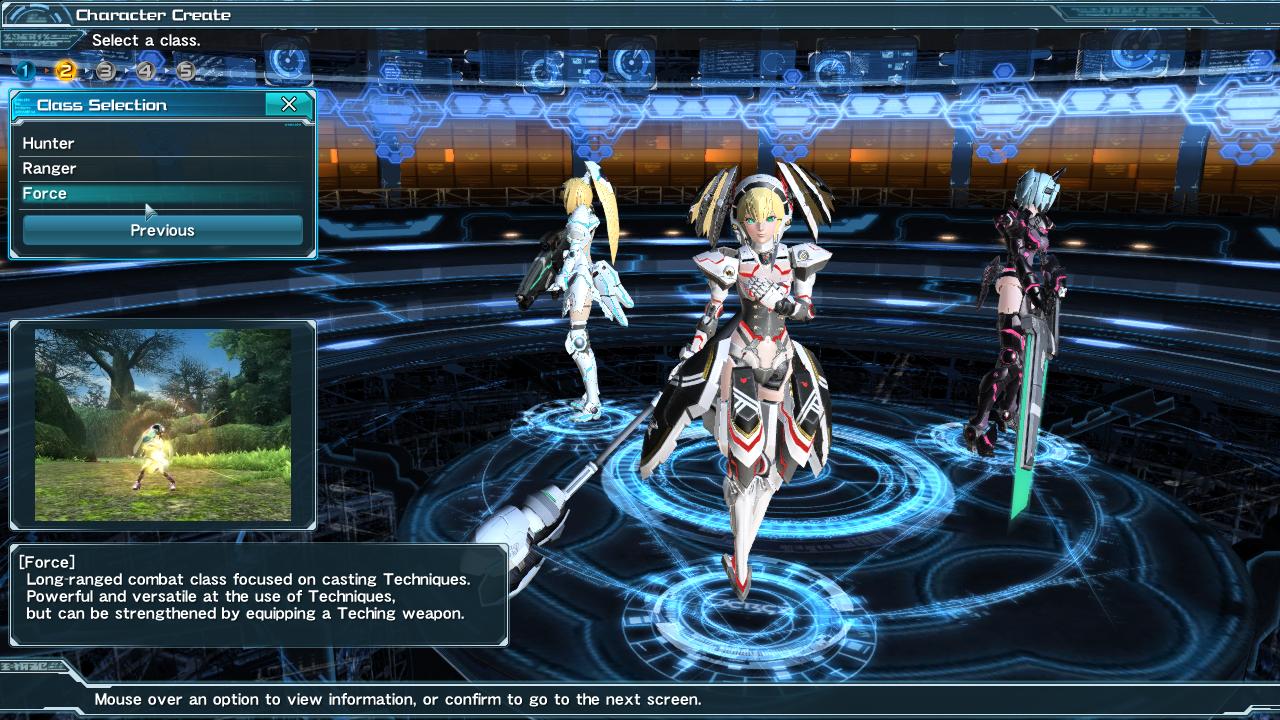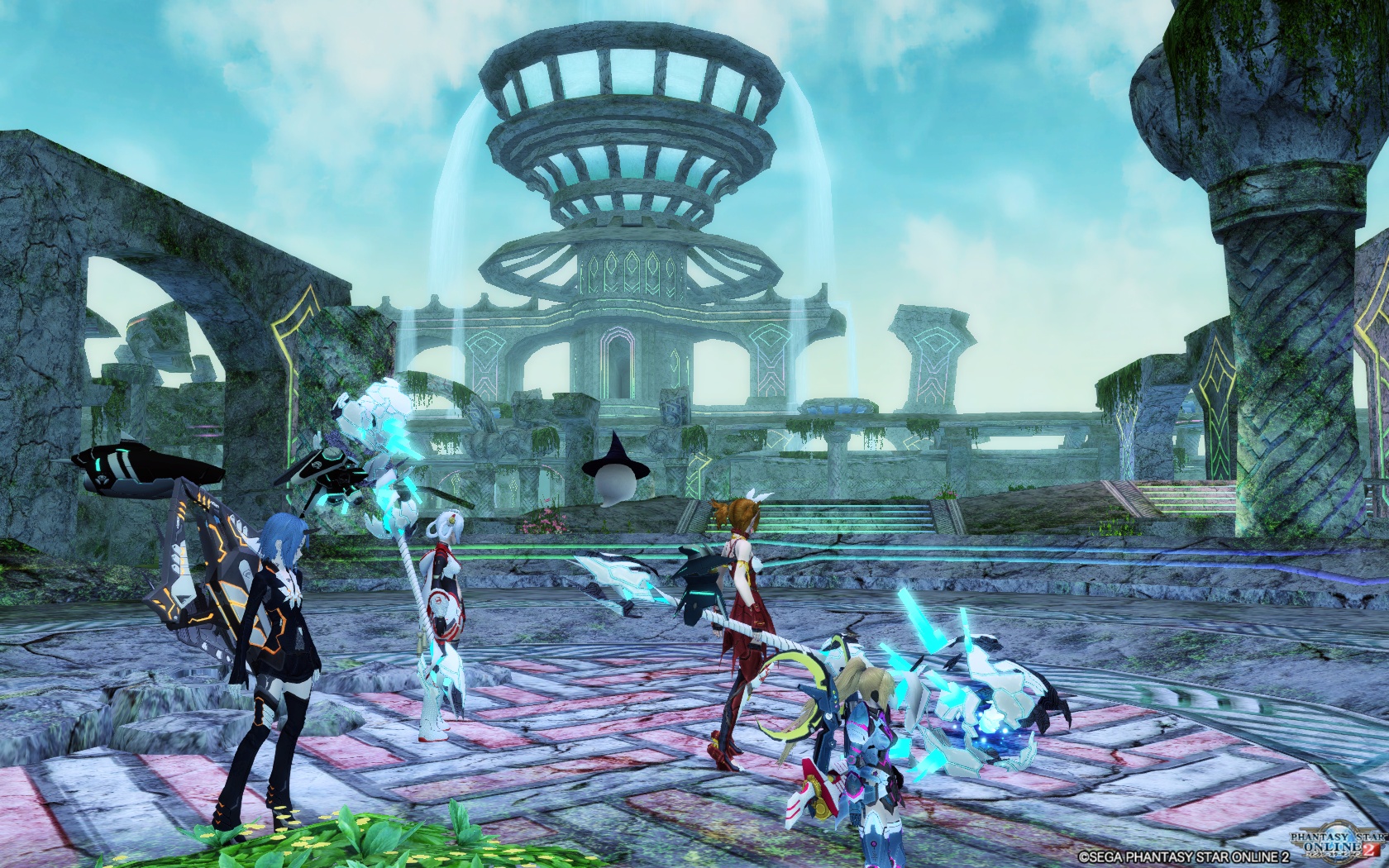Search
[{{{type}}}] {{{reason}}}
{{/data.error.root_cause}}{{{_source.title}}} {{#_source.showPrice}} {{{_source.displayPrice}}} {{/_source.showPrice}}
{{#_source.showLink}} {{/_source.showLink}} {{#_source.showDate}}{{{_source.displayDate}}}
{{/_source.showDate}}{{{_source.description}}}
{{#_source.additionalInfo}}{{#_source.additionalFields}} {{#title}} {{{label}}}: {{{title}}} {{/title}} {{/_source.additionalFields}}
{{/_source.additionalInfo}}Phantasy Star Online 2 (PC)

Phantasy Star Online 2
Developed By: Sega
Published By: Sega
Released: July 4, 2012
Available On: PlayStation 4, Switch, Vita, Windows
Genre: Action, RPG, MMO
ESRB Rating: N/A (in Japan, CERO C – ages 15+)
Number of Players: MMO (1-12 in-quest)
Price: Free with optional microtransactions
In the distant past of 2012, Sega finally released a proper sequel to its hit Dreamcast/GameCube MMO, Phantasy Star Online. While it started in Japan, Sega assured its fans that it would come west in 2013. Five years later, Sega stopped pretending they were interested in offering support to non-Japanese customers, taking down the English version of the Phantasy Star Online 2 website. However, thanks to the efforts of a dedicated few, PSO2 is now fully playable in English – with a decent amount of effort, at least.
As an MMO, PSO2 works rather differently from your standard open-world, tab-targeting affair. You’ll mostly see other players only in the lobby between missions; once you choose your quest, you’re placed in an instanced area. Depending on the mission, you’ll be by yourself, or joined with up to four, eight, or twelve other players. For the most part, quests involve navigating a randomly-generated, monster-filled map or two on your way to a boss arena. Defeat the boss, grab your loot, and head back to the lobby to start over again.
The most obvious departure from the norm is in the gameplay: PSO2 plays more like an action RPG than an MMO. You’re not glued to a spot while you go through an attack rotation – mobility is extremely important, and dodging and blocking are one hundred percent player-controlled. Only a select few class abilities have any cooldown, with attacks instead limited by your slowly-regenerating Photon Points. You can throw out weapon-based Photon Arts and magic-like Techniques with impunity until your PP dries up, though a few normal attacks will refill a hefty chunk of your meter. However, rather than spamming moves, timing is important, with properly-paced “just attacks” doing more damage. Enemies also aren’t one big hitbox, as nearly all of them have multiple spots to strike at, with some weaker than others; many foes even have breakable parts, which reveal weak spots or stun them once they take enough damage. There’s even a third-person shooter mode you can freely and easily switch into and out of for extra precision. With gamepad support and fully-customizable keybinds, it controls like a dream, as well. This is an active, fluid game, which helps it stand out from the MMO crowd.

Strong Points: More active and engaging gameplay than your standard MMO; fantastic character customization; tons of content; microtransactions are not required to fully enjoy the game
Weak Points: Only released in Japan; somewhat static class builds; nebulous mechanics, with information hard to come by (in English, at least); extremely grindy
Moral Warnings: Violence; blood; magic-like abilities; demonic and angelic enemies; lewd outfits galore; language (mostly PG-13); you’re technically breaking the terms of service by playing this game at all
Buoying this active combat are ten classes, each with one to three weapon types to choose from. These run the gamut between striking (the tanky Hunter and the glass cannon Fighter), ranged (the sharpshooting Ranger and the up-close-and-personal Gunner), and tech (the offensive Force and the supporting Techer), along with the striking-tech hybrid Bouncer, the striking-ranged mashup Braver, the pet-raising Summoner, and the jack-of-all-trades Hero. Each weapon a class can natively equip brings a different playstyle, sometimes vastly so: within the Hunter class, for instance, the slow-and-steady sword feels a lot different than the quick-hitting partizan and the enemy-grappling wired lances. You can even take any of the other classes as a subclass, gifting you their skill trees, abilities, and a portion of their stats. You can change main and subclasses at will, which helps to breathe fresh air into the game if one class is getting stale.
The variety in classes, however, doesn’t really translate to their builds. As you level up each class, you earn skill points to put into a skill tree; these skills vary from straight damage increases to unlocking specific class mechanics. Each class, however, only really has one or two effective builds, with others being prohibitively niche, sub-par, or straight-up terrible. A Hunter will build around either Fury Stance or Guard Stance, with most everything else being identical; a Ranger without Standing Snipe is gimping itself, even if you want to run-and-gun; almost every Force will have Techer as a subclass, with little reason to even experiment elsewhere. Thanks to ever-increasing level caps and ensuing skill point bloat, some classes, such as Bouncer, almost have more points than useful skills.
Worse yet, the game doesn’t always communicate its mechanics too well – being Japan-only, English help is limited. Outside of mechanics that Sega introduced and then promptly forgot about (and there are more than a few of those), plenty of even simple ideas gain a layer of obtuseness. At worst, failure to properly research can necessitate remaking your character, or dropping money to fix it: skill trees can’t be reset without a cash-shop-only Reset Pass, though Sega does give out free ones each time they change a skill. The worse offender comes in the form of your mag, a little helper robot that you feed items to increase your stats. The only useful mag is one with the maximum 200 points in the specific attack stat you want, and fixing a mag with points in something useless costs either a boatload of in-game resources or some real-life cash.
That said, PSO2 is rather friendly to free-to-play gamers – at least, those with a lot of time on their hands. While there is a loot box-esque “scratch card” system, nearly everything can be sold on the player shop for in-game money. Most of the items are clothing and costumes, which complement the comprehensive character customization – the true endgame of PSO2 is making your characters look as fabulous as possible. Just be prepared to grind a lot to get there (in a literal sense – per Phantasy Star tradition, strengthening your weapons and armor is called “grinding”). Between fighting the cruel RNG to find your gear, fighting the similarly-cruel RNG to grind your gear, fighting the very cruel RNG to affix your gear with stat-boosting abilities, and gaming a system or two to get money and consumables for the previous three, you’ll have to sink a ton of time into it to get into top form. If you want to, that is; a casual player can experience just as much as a hardcore one, as long as you stay away from the Extra Hard difficulty.

Higher is better
(10/10 is perfect)
Game Score - 83%
Gameplay - 17/20
Graphics - 8/10
Sound - 7/10
Stability - 4.5/5
Controls - 5/5
Morality Score - 69%
Violence - 4/10
Language - 7/10
Sexual Content - 6.5/10
Occult/Supernatural - 7/10
Cultural/Moral/Ethical - 10/10
For a six-year-old game, PSO2 has aged decently well, thanks in part to its unique art style – the sci-fi/fantasy blend works as well now as it did on the Dreamcast with the first PSO. Enemy models keep getting bigger and more detailed, though the same can’t be said of the player and NPCs – once you notice that hands don’t animate, there’s no going back. There’s a wide variety of environments, plenty of foes to fight, and no shortage of stylish moves. Enemies are well-designed both visually and gameplay-wise – most attacks are telegraphed one way or another, even if it takes a few tries to learn how to counter properly. The visual and audio cues are properly conveyed: subtle enough to stay out of the way, but clear enough to communicate what’s needed. The music itself, while having tons of tracks, only has a few stand-out songs. It does, at least, carry over the first PSO’s tradition of dynamically changing into and out of a higher-energy track when combat starts or ends.
Morally, violence is a given, though you rarely fight humanoid foes. Defeated enemies fall over and disappear; while story cutscenes can occasionally show blood, there’s none to be found in game. Techniques are basically elemental magic with a sci-fi veneer, though some enemies do summon magic circles when they attack. There’s an entire class of “demon” enemies, though most are standard fantasy fare: orcs, goblins, minotaurs, etc. Phantoms, however, come in a “Deus” subset, which look distinctly angelic; a raid boss of this type is presented as a 'god.' Many clothing options show a lot of skin, both male and female, and both for players and NPCs. There’s some language in the game, mostly of the PG-13 variety – though, to be fair, there’s a lot of story content I haven’t played through, so it might get worse. Standard MMO player base shenanigans apply here as well, with the added "bonus" of the game allowing you to send pictures over the in-game chat system.
Finally, there’s a potential real-world issue to bring up: PSO2’s terms of service forbid playing from outside Japan. Sega, for their part, hasn’t cared for years, and freely let foreigners play – just don’t expect any support from them. Getting the game working in English requires a fair amount of work, including using a torrent to download the game – this is technically optional, but far easier than going through the official channels. There are extensive guides available to help you every step of the way – just be aware that simply playing the game requires third-party software, maybe a torrent, and circumventing Sega’s (rather archaic) GameGuard anti-cheat DRM. If any of this rubs you the wrong way, you might be better off skipping this game.
For everyone else, Phantasy Star Online 2 is worth checking out, if you’ve got the patience for it. The fluid, active gameplay is perhaps the best you can find in an MMO, and there’s plenty of content to be had. Sega has stated they plan to continue development for years, so there appears to be little risk of the game folding if you start now.
Also, no, the game is not getting an official English release. With all the crossovers, covering everything from Persona to Monster Hunter to Steins;Gate, the licensing alone would be a nightmare. This is the best you’re going to get – but it’s still pretty good, all told. If you're looking to start, [url=http://www.bumped.org/psublog/phantasy-star-online-2-registration-guide/]here is an in-depth registration guide[/url]; the site itself contains plenty of English information and helpful links to get you on your feet.
-Cadogan








